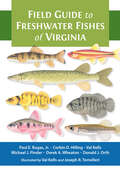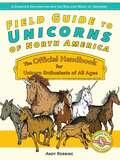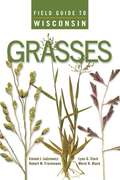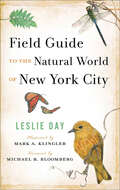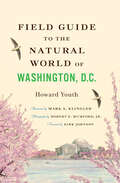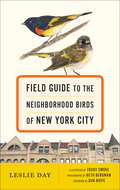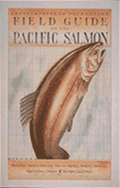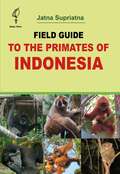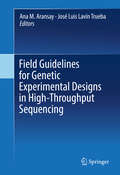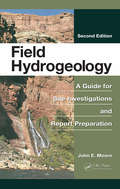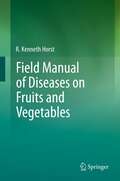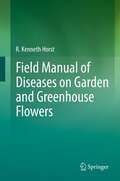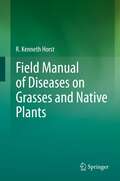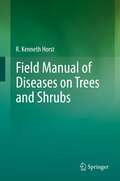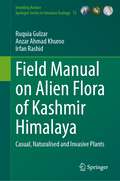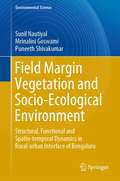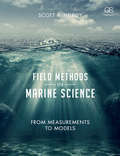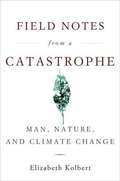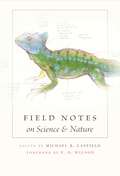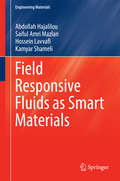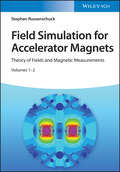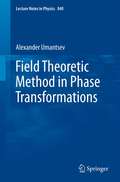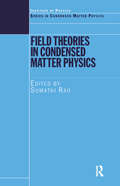- Table View
- List View
Field Guide to Freshwater Fishes of Virginia
by Corbin D. Hilling Valerie A. Kells Michael J. Pinder Derek A. Wheaton Paul E. Bugas Jr. Donald J. OrthA beautifully illustrated guide to the diverse and numerous freshwater fish species in Virginia.In Field Guide to Freshwater Fishes of Virginia, the foremost experts on Commonwealth fishes bring their decades of field experience to readers, offering a complete reference to the fishes of the entire state of Virginia. Gathering information that until now could only be found scattered across numerous reference works and online databases, this book provides everything you need to know to identify fish families and species in the Virginia region. Covering how to collect, handle, observe, conserve, and protect these unique fishes, the book's key features include • more than 175 vibrant, full-color illustrations, set side by side with descriptions of each fish• helpful line drawings that depict the most reliable diagnostic characteristics for field identifications (e.g., snout shape, pigment patterns, mouth morphology)• descriptions of Virginia's freshwater habitats • examples of incredible fish spawning and feeding behavior• tips on observing fish in the wild and in captivity• a chapter on the taxonomy of family and common names of the fish species most common throughout Virginia• up-to-date fish distribution maps• a complete glossary of termsProviding a fascinating foray into the wonders of the Commonwealth's swimmers, Field Guide to Freshwater Fishes of Virginia will appeal to scientists, naturalists, teachers, native fish aquarists, students, anglers, and fish collectors.
Field Guide to Unicorns of North America: The Official Handbook for Unicorn Enthusiasts of All Ages
by Andy RobbinsBecome an expert on the various species of North American Unicornus thanks to this fun, funny, and fascinating field guide!From historical details to identification strategies, you&’ll soon be immersed in the world of unicorns that roam the wilds of North America thanks to the scientific, "fact-packed" handbook. Plus, you&’ll learn easy, step-by-step drawing techniques for when you&’re out in the wild searching for signs of unicorn presence. Along with unicorn history, popular tales, and scientific information, you&’ll be provided with in-depth details about the most popular species of North American unicorns, including: • American Unicorn • Hoary Unicorn • Spiked Bog Pony • Tropical Unicorn • And more! This field guide is perfect for any lover of these fantastic beasts, no matter if they believe unicorns to be fact or fiction!
Field Guide to Wisconsin Grasses
by Lynn G. Clark Emmet J. Judziewicz Robert W. Freckmann Merel R. BlackGrasses are the foremost plant family of prairies, savannas, barrens, many agricultural landscapes, lawns, and successional habitats throughout Wisconsin, yet they are notoriously difficult to identify. This field guide to 232 species of Wisconsin grasses includes more than 1,100 illustrations. Setting a new standard as the first new, illustrated midwestern grass identification manual to appear since the 1960s, it provides up-to-date, comprehensive information for naturalists, gardeners, landscapers, nursery horticulturalists, community restoration professionals, agronomists and biologists, and any outdoors lover. The book includes: #149; species descriptions and distribution maps for all 232 species #149; more than 700 color photographs accompanying species descriptions #149; drawings of most species #149; chapters on grass morphology and grasses in natural communities #149; keys to all species, including an illustrated key to genera #149; a glossary of grass terminology.
Field Guide to the Natural World of New York City
by Leslie Day“This little gem fills you in on everything finned, furred, feathered, or leafed, and how to find it, in all five boroughs” (House and Garden).New York just might be the most biologically diverse city in temperate America. The five boroughs sit atop one of the most naturally rich sites in North America, directly under the Atlantic migratory flyway, at the mouth of a 300-mile-long river, and on three islands?Manhattan, Staten, and Long.Leslie Day, a New York City naturalist, reveals this amazing world in her Field Guide to the Natural World of New York City. Combining the stunning paintings of Mark A. Klingler with a variety of photographs and maps, this book is a complete guide for the urban naturalist?with tips on identifying the city's flora and fauna and maps showing the nearest subway stop.Here is your personal guide to the real wild side of America’s largest city. Throw it in your backpack, hop on the subway, and explore.“Dr. Day . . . A sort of Julia Child of nature.” —Ellen Pall, New York Times“Provides historic facts, photographs and maps to give a snapshot of the city’s natural resources and to remind hard-charging New Yorkers of the unchanging parts of their environment.” —Sally Goldenberg, Staten Island Advance“This book should be in every New Yorker’s library as both reference and inspiration for low-carbon-impact journeys to places of unexpected beauty and tranquility.” —Crawford-Doyle Booksellers Newsletter“You may well wonder why I am reviewing a book about New York city when we preach 'local, local, local' throughout these pages. I'll tell you, because this beautifully illustrated handbook is a wonderful example of exploring the bucolic city. . . . All illustrated with gorgeous watercolors by Klingler. We should have one of these. But in the meantime, you will find many of the same species in our fair cities., so why not pick up a copy for inspiration?”—Minneapolis Observer Quarterly
Field Guide to the Natural World of Washington, D.C.
by Howard YouthA field guide to plants and animals commonly found in the nation's capital.Winner of the Design and Effectiveness Award of the Washington PublishersNature awaits discovery at almost every turn in the complex ecosystem of Washington, D.C. In parks large and small, within the District's gardens, and on public streets, there is tremendous biodiversity. In Field Guide to the Natural World of Washington, D.C., naturalist Howard Youth takes us on an urban safari, describing the wild side of the nation's capital.Beyond the abundant wildlife that can be seen in every neighborhood, Washington boasts a large park network rich in natural wonders. A hike along the trails of Rock Creek Park, one of the country’s largest and oldest urban forests, quickly reveals white-tailed deer, eastern gray squirrels, and little brown bats. Mayapples, Virginia bluebells, and red mulberry trees are but a few of the treasures found growing at the National Arboretum. A stroll along the Potomac and Anacostia Rivers might reveal stealthy denizens such as bullfrogs, largemouth bass, and common snapping turtles. Detailed drawings by Carnegie artist Mark A. Klingler and photography by Robert E. Mumford, Jr., reveal the rich color and stunning beauty of the flora and fauna awaiting every D.C. naturalist.Whether seeking a secluded jog or an adventurous outing, residents and tourists alike will find this handsome guide indispensable for finding oases away from the noise of the city.
Field Guide to the Neighborhood Birds of New York City
by Leslie Day Don RiepeNew York City's favorite naturalist is back with a guided tour of the Big Apple that unveils the beautiful birds living in its midst.Winner of the Hardcover Nonfiction (Design) of The New York Book Show, Illustrated Text of the Washington PublishersLook around New York, and you’ll probably see birds: wood ducks swimming in Queens, a stalking black-crowned night-heron in Brooklyn, great horned owls perching in the Bronx, warblers feeding in Central Park, or Staten Island’s purple martins flying to and fro. You might spot hawks and falcons nesting on skyscrapers or robins belting out songs from trees along the street. America’s largest metropolis teems with birdlife in part because it sits within the great Atlantic flyway where migratory birds travel seasonally between north and south. The Big Apple’s miles of coastline, magnificent parks, and millions of trees attract dozens of migrating species every year and are also home year-round to scores of resident birds. There is no better way to identify and learn about New York’s birds than with this comprehensive field guide from New York City naturalist Leslie Day. Her book will quickly teach you what each species looks like, where they build their nests, what they eat, the sounds of their songs, what time of year they appear in the city, the shapes and colors of their eggs, and where in the five boroughs you can find them—which is often in the neighborhood you call home. The hundreds of stunning photographs by Beth Bergman and gorgeous illustrations by Trudy Smoke will help you identify the ninety avian species commonly seen in New York. Once you enter the world of the city’s birds, life in the great metropolis will never look the same.
Field Guide to the Neighborhood Birds of New York City
by Leslie DayNew York City’s favorite naturalist returns with a guided tour of the beautiful birds living in the five boroughs.Look around New York, and you’ll probably see birds: wood ducks swimming in Queens, a stalking black-crowned night-heron in Brooklyn, great horned owls perching in the Bronx, warblers feeding in Central Park, or Staten Island’s purple martins flying to and fro. You might spot hawks and falcons nesting on skyscrapers or robins belting out songs from trees along the street.America’s largest metropolis teems with birdlife in part because it sits within the great Atlantic flyway where migratory birds travel seasonally between north and south. The Big Apple’s miles of coastline, magnificent parks, and millions of trees attract dozens of migrating species every year and are also home year-round to scores of resident birds.There is no better way to identify and learn about New York’s birds than with this comprehensive field guide from New York City naturalist Leslie Day. Her book will quickly teach you what each species looks like, where they build their nests, what they eat, the sounds of their songs, what time of year they appear in the city, the shapes and colors of their eggs, and where in the five boroughs you can find them?which is often in the neighborhood you call home. The hundreds of stunning photographs by Beth Bergman and gorgeous illustrations by Trudy Smoke will help you identify the ninety avian species commonly seen in New York. Once you enter the world of the city’s birds, life in the great metropolis will never look the same.“‘Take this guide wherever you go,’ [Day] implores readers in the introduction. And we hope many do, since it reveals a New York we long to see, the wild, beautiful city of birds known to Audubon, Chapman, and Griscom.” —Chuck Hagner, BirdWatching Magazine“An excellent guide for New York City residents. If you have any interest in the birds around you (and there are plenty of birds around you, even in NYC), this guide will really open your eyes.” —Birder's Library“Day’s deeply researched and richly illustrated Field Guide to the Neighborhood Birds of New York City will be indispensable to locals and tourists alike.” —Sierra“Will fill a niche for beginning birders and backyard watchers in the northeastern U.S.” —Choice“You don’t have to live in or be visiting New York to enjoy this book.” —Times Literary Supplement (UK)
Field Guide to the Primates of Indonesia
by Jatna SupriatnaThis primate field guide can be used to refer to information on each species, or it can be used to find which species exist on each island, as shown at the back of the book. A list of primates in Indonesia is provided with local, English, and scientific names. Once the name is identified the user can go to the description of the genus and species. Also given is the conservation status of each species except for the most recently described, whose status is not yet known. The information on each species' natural history, behavior, ecology, and where to see it in parks and/or forested areas outside parks is included. Field Guide to the Primates of Indonesia primate drawings are by Stephen Nash and photographs were donated by many of the author's friends from Indonesia and abroad.
Field Guidelines for Genetic Experimental Designs in High-Throughput Sequencing
by Ana M. Aransay José Luis Lavín TruebaHigh throughput sequencing (HTS) technologies have conquered the genomics and epigenomics worlds. The applications of HTS methods are wide, and can be used to sequence everything from whole or partial genomes, transcriptomes, non-coding RNAs, ribosome profiling, to single-cell sequencing. Having such diversity of alternatives, there is a demand for information by research scientists without experience in HTS that need to choose the most suitable methodology or combination of platforms and to define their experimental designs to achieve their specific objectives. Field Guidelines for Genetic Experimental Designs in High-Throughput Sequencing aims to collect in a single volume all aspects that should be taken into account when HTS technologies are being incorporated into a research project and the reasons behind them. Moreover, examples of several successful strategies will be analyzed to make the point of the crucial features. This book will be of use to all scientist that are unfamiliar with HTS and want to incorporate such technologies to their research.
Field Hydrogeology: A Guide for Site Investigations and Report Preparation, Second Edition
by John E. MooreIn recent years, the focus in hydrogeologic investigations has expanded to include aquifer sustainability as part of resource evaluations. While there are other books on the subject, Field Hydrogeology: A Guide for Site Investigations and Report Preparation provides the first integrated presentation of the American Society of Testing Materials (AST
Field Manual of Diseases on Fruits and Vegetables
by R. Kenneth HorstThe Fruits and Vegetables manual is a reference manual on diseases which attack fruits (including berries), vegetables, and nuts. The manual identifies various types of diseases which are known to invade these plants located throughout North, Central, and South America. The recordings include diseases caused by fungi, bacteria, viruses, viroids, phytoplasmas, and nematodes. Causal disease agents are described and illustrated in some cases and diseases and disease control measures are also discussed. A manual such as this is never finished since new reports of diseases are continuously reported.
Field Manual of Diseases on Garden and Greenhouse Flowers
by R. Kenneth HorstThe Garden and Greenhouse Flowers manual is a reference manual on diseases which attack garden and greenhouse flowers. The manual identifies various types of diseases which are known to invade these plants located throughout North, Central, and South America.The recordings include diseases caused by fungi, bacteria, viruses, viroids, phytoplasmas, and nematodes. Causal disease agents are described and illustrated in some cases and diseases and disease control measures are also discussed. A manual such as this is never finished since new reports of diseases are continuously reported.
Field Manual of Diseases on Grasses and Native Plants
by R. Kenneth HorstThe Grasses and Native Plants manual is a reference manual on diseases which attack grasses, forage, native flowers, and weeds. The manual identifies various types of diseases which are known to invade these plants located throughout North, Central, and South America. The recordings include diseases caused by fungi, bacteria, viruses, viroids, phytoplasmas, and nematodes. Causal disease agents are described and illustrated in some cases and diseases and disease control measures are also discussed. A manual such as this is never finished since new reports of diseases are continuously reported.
Field Manual of Diseases on Trees and Shrubs
by R. Kenneth HorstThe Trees and Shrubs manual is a reference manual on diseases which attack trees, shrubs, and vines. The manual identifies various types of diseases which are known to invade these plants located throughout North, Central, and South America. The recordings include diseases caused by fungi, bacteria, viruses, viroids, phytoplasmas, and nematodes. Causal disease agents are described and illustrated in some cases and diseases and disease control measures are also discussed. A manual such as this is never finished since new reports of diseases are continuously reported.
Field Manual on Alien Flora of Kashmir Himalaya: Casual, Naturalised and Invasive Plants (Invading Nature - Springer Series in Invasion Ecology #15)
by Ruquia Gulzar Anzar Ahmad Khuroo Irfan RashidThe book “Field Manual on Alien Flora of Kashmir Himalaya: Casual, Naturalised and Invasive Plants” has been prepared with two main goals in mind: (i) to promote awareness on the threats of invasive alien plants to biodiversity, ecology and environment, and (ii) to encourage research on, and management of, the alien plants. The Manual contains concise information on the taxonomy, ecology, invasion status, impacts, distribution and illustrated photo-plates of the alien plant species of Kashmir Himalaya, India. The Manual has three chapters: Chapter-I provides a general introduction to the discipline of invasion ecology. Chapter-II guides the readers on how to use the Manual, including brief information on the study region, methods, definitions and terminology used. Chapter-III comprises the bulk of this Manual, providing profile of 100 alien plant species with scientific information on the botanical, english and local names, taxonomic characters, ecological traits, current invasion status (casual, naturalised and invasive), impacts, native range, species’ distribution-map in Kashmir Himalaya and coloured illustrations that will aid in field identification. It is hoped that the Manual will increase awareness on the threats posed by plant invasions among all the stakeholders - researchers, land managers, policy makers, environmentalists, naturalists, citizen-scientists, students, and the general public. It will also help in promoting research, formulating policies and planning management actions to deal with invasive alien species.
Field Margin Vegetation and Socio-Ecological Environment: Structural, Functional and Spatio-temporal Dynamics in Rural-urban Interface of Bengaluru (Environmental Science and Engineering)
by Sunil Nautiyal Mrinalini Goswami Puneeth ShivakumarThis book has been produced as a part of the project ‘Social-Ecological Systems at the Indian Rural-Urban Interface: Functions, Scales, and Dynamics of Transition’. It addresses transition processes in agriculture and society triggered by urbanization, focusing on Bengaluru as an example of a rapidly growing megacity in India. Adopting a holistic, multidisciplinary approach embedded within a social-ecological systems research framework, it explores how the physical and socio-economic landscapes have led to changes in economic priorities, which have overpowered ecological and traditional priorities with regard to ecosystem governance. Allowing readers to gain a deeper understanding of this unexplored dimension of socio-ecological systems, this book is a valuable resource for international researchers, scholars and master’s students in the field of environmental science, socio-ecology, forestry and agriculture.
Field Methods in Marine Science: From Measurements to Models
by Scott MilroyField Methods in Marine Science: From Measurements to Models is an authoritative guide of the methods most appropriate for field research within the marine sciences, from experimental design to data analysis. Written for upper-level undergraduate and graduate students as well as early-career researchers, this textbook also serves as an accessible introduction to the concepts and practice of modeling marine system dynamics. This textbook trains the next generation of field scientists to move beyond the classic methods of data collection and statistical analysis to contemporary methods of numerical modeling; to pursue the assimilation and synthesis of information, not the mere recording of data. Boxes and side bars highlight important questions, interesting facts, relevant examples, and research techniques that supplement the text. Students and researchers alike will find the thorough appendices useful as a way of expanding comprehension of fundamental concepts.
Field Notes from a Catastrophe: Man, Nature, and Climate Change
by Elizabeth KolbertAn argument for the danger of global warming in a book that is sure to be as influential as Rachel Carson's "Silent Spring," Known for her insightful journalism, "New Yorker" writer Elizabeth now tackles the controversial subject of global warming.
Field Notes on Science and Nature
by Michael R. CanfieldOnce in a great while, as the New York Times noted recently, a naturalist writes a book that changes the way people look at the living world. John James Audubonâe(tm)s Birds of America, published in 1838, was one. Roger Tory Petersonâe(tm)s 1934 Field Guide to the Birds was another. How does such insight into nature develop? Pioneering a new niche in the study of plants and animals in their native habitat, Field Notes on Science and Nature allows readers to peer over the shoulders and into the notebooks of a dozen eminent field workers, to study firsthand their observational methods, materials, and fleeting impressions. What did George Schaller note when studying the lions of the Serengeti? What lists did Kenn Kaufman keep during his 1973 âeoebig yearâe#157;? How does Piotr Naskrecki use relational databases and electronic field notes? In what way is Bernd Heinrichâe(tm)s approach âeoetruly Thoreauvian,âe#157; in E. O. Wilsonâe(tm)s view? Recording observations in the field is an indispensable scientific skill, but researchers are not generally willing to share their personal records with others. Here, for the first time, are reproductions of actual pages from notebooks. And in essays abounding with fascinating anecdotes, the authors reflect on the contexts in which the notes were taken. Covering disciplines as diverse as ornithology, entomology, ecology, paleontology, anthropology, botany, and animal behavior, Field Notes offers specific examples that professional naturalists can emulate to fine-tune their own field methods, along with practical advice that amateur naturalists and students can use to document their adventures.
Field Responsive Fluids as Smart Materials
by Abdollah Hajalilou Saiful Amri Mazlan Hossein Lavvafi Kamyar ShameliThis book is about field responsive fluids as smart materials, which includes magneto-rheological (MR) fluids, electro-rheological (ER) fluids and ferrofluids. It reviews the previous works and considers all the aspects that can help researchers and industries to choose proper materials as MR fluid constituents. Topics in magnetism and types of magnetic materials are presented. This includes the effect of magnetizable particles behaviors such as size, shape and density. The type of materials on the rheological properties is also compared for MR, ER and ferro-fluids. The second part of the book discusses advanced topics for MR, ER and ferro-fluids comparing some of the properties between the field responsive fluids. This book appeals to engineers, researchers and practitioners in the area of materials and mechanical engineering with interest in the field responsive fluids.
Field Simulation for Accelerator Magnets: Volume 1: Theory of Fields and Magnetic Measurements / Volume 2: Methods for Design and Optimization
by Stephan RussenschuckA comprehensive reference to the theory and practice of accelerator-magnet design and measurement Particle accelerators have many fundamental and applied research applications in physics, materials science, chemistry, and life science. To accelerate electrons or hadrons to the required energy, magnets of highly uniform fields are needed, whose design and optimization are some of the most critical aspects of accelerator construction. Field Simulation for Accelerator Magnets is a comprehensive two-volume reference work on the electromagnetic design of iron- and coil-dominated accelerator magnets and methods of magnetic-field measurements. It provides project engineers and beam physicists with the necessary mathematical foundations for their work. Students of electrical engineering and physics will likewise find much value in these volumes, as the challenges to be met for field quality, electrical integrity, and robustness of accelerator magnets require an in-depth knowledge of electromagnetism. Accelerator-magnet design provides an excellent opportunity to learn mathematical methods and numerical techniques that have wide-ranging applications in industry and science. Readers of the two volumes of this work will find: Authorship by the leading expert on magnetic fields of accelerator magnets Detailed discussion of topics such as vector algebra and analysis, network theory, analytical and numerical field computation, magnetic measurements, elementary beam optics, and many more Application of mathematical optimization techniques, multiphysics simulation, and model-based systems engineering
Field Theoretic Method in Phase Transformations
by Alexander UmantsevThe main subject of the book is the continuum, field theoretic method of study of phase transformations in material systems. The method, also known as "phase field", allows one to analyze different stages of transformations on the unified platform. It has received significant attention in the materials science community recently due to many successes in solving or illuminating important problems. The book will address fundamentals of the method starting from the classical theories of phase transitions, the most important theoretical and computational results, and some of the most advanced recent applications.
Field Theories in Condensed Matter Physics (Condensed Matter Physics)
by Sumathi RaoThe application of field theoretic techniques to problems in condensed matter physics has generated an array of concepts and mathematical techniques to attack a range of problems such as the theory of quantum phase transitions, the quantum Hall effect, and quantum wires. While concepts such as the renormalization group, topology, and bosonization h
Field Theories of Condensed Matter Physics
by Eduardo FradkinPresenting the physics of the most challenging problems in condensed matter using the conceptual framework of quantum field theory, this book is of great interest to physicists in condensed matter and high energy and string theorists, as well as mathematicians. Revised and updated, this second edition features new chapters on the renormalization group, the Luttinger liquid, gauge theory, topological fluids, topological insulators and quantum entanglement. The book begins with the basic concepts and tools, developing them gradually to bring readers to the issues currently faced at the frontiers of research, such as topological phases of matter, quantum and classical critical phenomena, quantum Hall effects and superconductors. Other topics covered include one-dimensional strongly correlated systems, quantum ordered and disordered phases, topological structures in condensed matter and in field theory and fractional statistics.
